Dishwasher: Why is my dishwasher noisy?
Like all home appliances, dishwashers can make loud sounds. Some noises are normal, like the hiss of water rushing through the water inlet fill valve or the hum of the pump motor, but when it produces strange or unexpected sounds, it’s important to investigate.
When your dishwasher is making these strange sounds, it’s best to try and diagnose the issue before it gets worse.
Grinding can be caused by broken glass or hard foods, like popcorn kernels, stuck in the chopper blade
A thumping noise could be the drain line vibrating against the cabinet
The wash pump and drain pump create loud buzzing sounds if they are broken
The wash pump motor may squeal if its bearings go bad
Other problems that can plague your dishwasher
Learn about the common reasons for unexpected dishwasher issues and determine if you can make repairs yourself. Sears Home Services has the parts and accessories that homeowners need for DIY dishwasher repairs. When in doubt, you can also schedule an appointment with the technicians to diagnose the issue, even if you don’t have a warranty.
Why does my dishwasher stop mid-cycle?
A dishwasher that stops unexpectedly can suggest that you have a broken door latch, failing heating element, faulty vent fan, tripped circuit breaker, sensor failure, or a broader control system issue.
Open and close the door to make sure it is latched. Then, check your home’s circuit breaker to see if the power source was cut off. If the cause is not obvious, Sears Home Services can help troubleshoot.
Why can't I adjust the dishwasher rack height?
The height adjustment functionality in a dishwasher makes it easier to load taller items. Over time, or if used forcefully, it can be damaged and cause the dish rack to sag. Sears Home Services can help you get the right [dishwasher parts](/category/1234583/dishwasher-parts) to restore function to your kitchen.
Why does my dishwasher hum, but there’s no water?
A dishwasher that makes a humming sound but won’t fill with water may have a damaged water inlet valve or broken overfill float switch. It may also be affected by hard water blockages.
First, check to make sure the water supply line and cut-off valve is open. Then, see if an object is preventing the overfill float from freely moving up and down. If the float assembly is stuck, the dishwasher fill valve won't let water into the dishwasher tub. If the valve and overfill float seem to be operating correctly, a failed electronic control board or timer could also prevent the dishwasher from filling.
How do I know if my inlet valve is bad on my dishwasher?
There are several common signs that a dishwasher water inlet valve is faulty. The appliance may fill slowly, or not at all. In fact, you might find that your dishes are dirty after the wash cycle, as if there wasn’t enough water in the appliance to circulate and clean. The valve may also fail to turn off when not in use, causing the dishwasher tub to fill with water between use.
Why is my dishwasher leaking?
If you see water leaking around the washer or from under the kickplate, take notice. Many [parts of a dishwasher](/diy/article/what-are-the-main-parts-of-a-dishwasher) could be affected, such as a damaged or stuck spray arm, a loose or broken door hinge, damaged pump seals, a leaking drain line, broken motor assembly, or a leak in the water inlet.
As many of these appliance repairs require you to uninstall the appliance for diagnostics, don’t hesitate to schedule an appointment with Sears Home Services for assistance if you need help.
Why won't my dishwasher drain?
There are several reasons why a dishwasher won’t drain:
A failing drain pump won’t remove water from the dishwasher
Debris clogging the drain and the impeller blade can prevent the sump area in the bottom of the dishwasher from draining
A malfunctioning check valve prevents water from backing up into the dishwasher sump through the drain hose. Water may drain out of the dishwasher while the drain pump runs but then flow back into the dishwasher after the drain pump stops.
Why does my dishwasher door drop open too fast?
If the dishwasher door drops without any resistance, a tension spring may be broken or disconnected, or the door hinges might be broken. Hinges can be replaced easily by a technician if they show signs of wear. If a dishwasher door spring is broken, it’s important to replace both springs at the same time to ensure that the control tension is the same on both sides of the door.
Why don't my dishes get dry?
Glass, ceramic, and metal dishes typically dry by the end of the dishwashing cycle, but an issue with the rinse aid dispenser, the heating element, or the drying fan can change that.
A heated drying setting is often turned off to save energy, but if your dishes aren't drying as well as you'd like them to, you might want to consider turning it back on to test which elements are not working in your dishwasher. You may be able to diagnose that the heating element is broken or that the thermostat for the element may have tripped in error.
Why won't my dishwasher start?
Diagnosing why a dishwasher won’t start isn’t always easy. It could be as obvious as a light switch in your home being off, lack of power source from your grid, a broken dishwasher door switch, or more serious wiring issues or control system failure.
Start by checking the door switch. If the door switch is okay, a damaged control panel, failed user interface control or broken electronic control board can prevent the dishwasher from starting. If your dishwasher uses a mechanical timer control, a failed timer can prevent the cycle from starting. Also, some dishwashers won't start if they don't fill with water. When in doubt, our knowledgeable technicians can help you get to the root of the issue and help make dishwasher repairs.

THESE REPAIRS MAY HELP SOLVE YOUR DISHWASHER PROBLEM
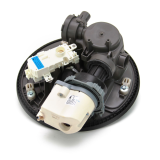
Replace the dishwasher circulation pump and motor assembly
Several situations can require the replacing the circulation pump and motor assembly in a dishwasher. If the motor on the circulation pump fails, then the dishwasher pump won't run at all. Sometimes the motor runs but doesn't generate water pressure through the spray arms, because the damaged impeller or pump housing is damaged. The pump housing and/or the seals could also deteriorate or become damaged, causing the dishwasher to leak. Problems inside the pump and motor assembly can create abnormal noises in the dishwasher. In all these situations, the pump and motor usually must be replaced.
Dishwasher circulation pump and motor assembly
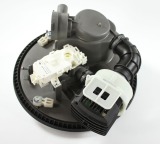
How to replace a dishwasher circulation pump and motor assembly
When the dishwasher spray arm won't spray, the problem could be the circulation pump or the pump motor. Installing a new dishwasher circulation pump and motor assembly costs about as much as just replacing the motor, and is easier. This DIY repair guide with video shows how to replace a dishwasher circulation pump that's not working.
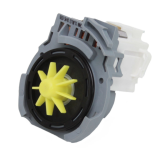
Replace the dishwasher drain pump
Replace the dishwasher drain pump if it's cracked or damaged, or if the drain pump doesn't pump out water. Before replacing, check the drain path (drain hose, sink drain and sump) to make sure it's not blocked. If the drain path is clear and water doesn't pump out, the drain pump has failed. Replace the drain pump if it won't run even though it's getting run voltage from the timer or control board.
Dishwasher drain pump
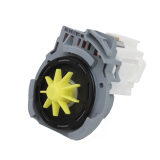
How to replace a dishwasher drain pump
If the dishwasher doesn’t drain, the problem could be the drain pump, even if you hear the pump running. You can replace the pump in about 30 minutes, following the steps in this repair guide and video.
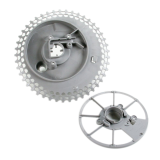
Clear the dishwasher chopper blade area
A kernel of popcorn or a similar foreign object can drop into the chopper blade area of the dishwasher, causing a loud grinding noise when the pump runs. Remove the lower spray arm and the upper part of the dishwasher sump to access and clear debris from the chopper blade area. If the chopper blade is damaged, replace it.
Clear the dishwasher chopper blade area
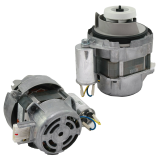
Replace the dishwasher wash pump motor
The wash pump motor, which is mounted on the sump under the dishwasher, spins the wash pump impeller. The wash pump motor will make a loud noise when it is defective. You may also see cleaning problems due to decreased spray pressure. If the pump motor is bad, it will need to be replaced. The motor can usually be released and removed from the sump under the dishwasher tub. Consider replacing the water seals as well when the new wash pump motor is installed for optimal performance.
Dishwasher wash pump motor
Most common symptoms to help you fix your dishwashers
Choose a symptom to see related dishwasher repairs.
Main causes: broken door spring, damaged or broken door hinge…
Main causes: damaged or stuck spray arm, leaking door seal, damaged door hinge, leaky heating element water seal, cracke…
Main causes: broken door latch, tripped circuit breaker, broken heating element, faulty vent fan, sensor failure, contro…
Main causes: improper loading, low water temperature, improper detergent dosage, detergent dispenser failure, spray arm …
Main causes: clogged kitchen sink drain, clogged drain hose, drain check valve damaged, drain pump failure, control syst…
Main cause: damaged rack height adjuster…
Main causes: glass or popcorn kernel stuck in the chopper blade, drain line vibrating against the cabinet, debris in was…
Main causes: not using rinse aid, rinse aid dispenser failure, broken heating element, malfunctioning vent, drying fan f…
Main causes: light switch beside the sink turned off, lack of power, bad dishwasher door switch, control system failure,…
Most common repair guides to help fix your dishwashers
These step-by-step repair guides will help you safely fix what’s broken on your dishwasher.

How to replace a dishwasher water inlet valve
If your dishwasher fills constantly or won't fill at all, the water inlet valve has failed. You can replace it in about …
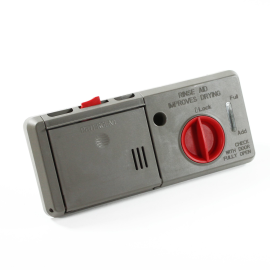
How to replace a dishwasher detergent dispenser
Dishes need dish detergent to get clean. Learn how to replace a dishwasher detergent dispenser with easy step-by-step i…
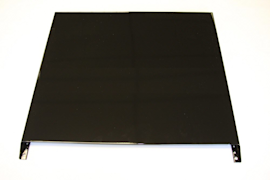
How to replace a dishwasher door outer panel
If your dishwasher door is dented or you want it to match your cabinets or other appliances, this guide shows how to rep…
Effective articles & videos to help repair your dishwashers
Use the advice and tips in these articles and videos to get the most out of your dishwasher.

Get tips on completing essential holiday cleaning tasks to brighten your home.…

Learn about all the convenient features on our Sears PartsDirect website that make your parts purchases easier.…
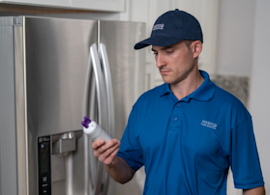
Get answers to frequently asked questions about Sears and Sears PartsDirect.…
